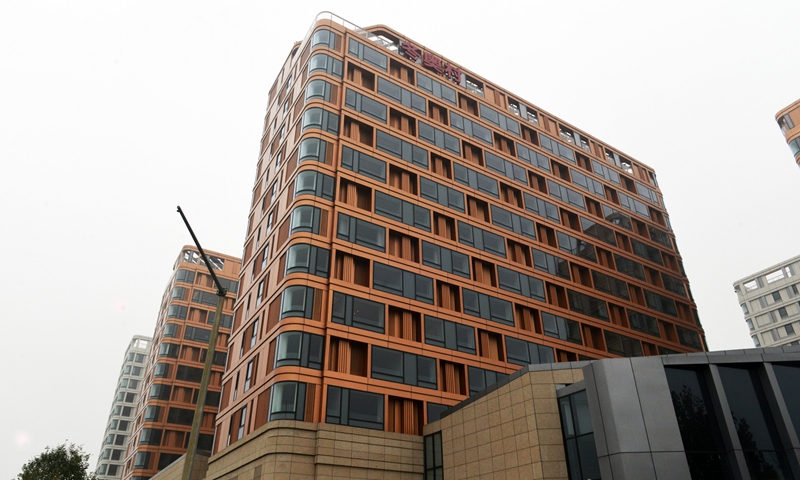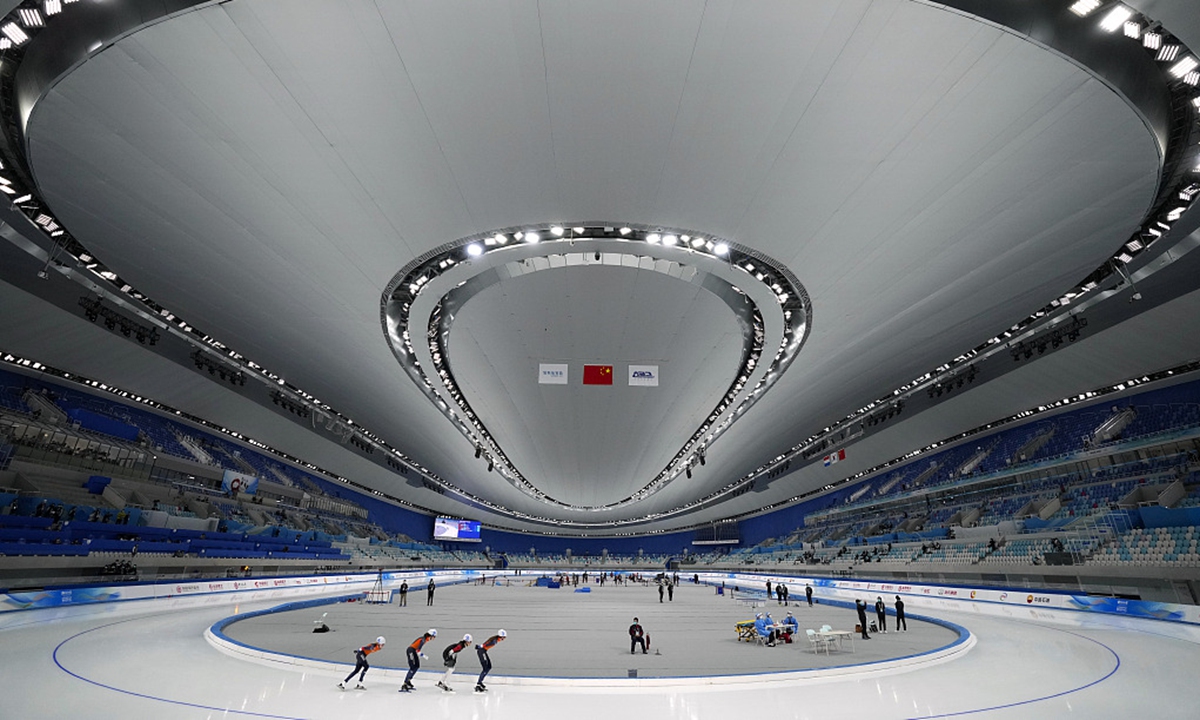
The Beijing Winter Olympic Village in Haidian district, Beijing. Photo: Zhao Juecheng/GT
While the competition venues for the Beijing Winter Olympics are undergoing final adjustment and handover, the Olympic Village, the living area of the athletes, is also subject to intense preparations. Within half a month, it will undergo a stress test and will officially start receiving athletes at the end of January.
On Friday, the Global Times reporters visited the Beijing Winter Olympic Village, which fully embodies the idea of green and intelligence, and incorporates many Chinese elements, just like the Olympic venues.
The Beijing Winter Olympic Village is one of the three Winter Olympic Villages built for the Beijing 2022 and the largest non-competition venue. It has a total construction area of about 330,000 square meters and is about two kilometers away from the competition venue area.

Members of the Chinese and Netherlands teams compete in the women's mass start during the Speed Skating China Open, a test event for the 2022 Winter Olympics, at the National Speed Skating Oval in Beijing, on Oct. 10. Photo: CFP
During the Winter Olympics, the Village will provide 2,338 beds for the athletes and officials, and about 1,040 beds during the Winter Paralympics, Song Jiaye, the deputy director of the urban stadium construction division of the Beijing Major Project Office, said on Friday.
The delegation reception center, the first stop for athletes and officials, was rebuilt on the site of an old industrial factory. Within the village, specialized robots are among the most important service personnel.
In the lobby, there are not only language service and navigation robots, but also tea-making robots and cooking robots ready to serve the delegations. The lobby is also equipped with smart dining tables, smart dining cabinets and other facilities.
The building complex within the Village has fully passed the green building three-star (highest) certification, constructed in accordance with ultra-low energy building standards, covering almost all energy-saving building standards.
The residential area for athletes cuts traditional heating and air conditioning appliances, but adjusts the room temperature through the design of the central ventilation system and glass curtain walls, which greatly saves energy consumption, Li Bin from the Beijing 2022 operation team said on Friday.
The design of the residential area fully considers for athletes and officials with physical disabilities, and has been designed for barrier-free in all aspects, Li said.
Inspecting the apartments, we can see an emergency button is set up just above the night stand in every bedroom. The indoor wardrobe adopts a push-open door design. The bathroom is designed with a non-slip floor, a toilet with handrails on both sides and a roll-in shower.
The construction team also emphasized Village's role as an important part of closed-loop management in terms of Covid-19 prevention.
The delegation reception center will be the first stop for a foreign delegation after arriving in Beijing. After arriving at the reception center from the airport, athletes and officials who have completed the COVID-19 vaccination will directly enter closed-loop management protocols and will not contact the outside world, Zhao Yuyan, manager of the reception center, said.
The athlete's life square is a "red zone," a space with the most personnel contact. In its design, the circulation of athletes, service personnel, and logistics personnel are strictly limited to ensure that contact of different groups are reduced to the greatest extent. All groups have its own entry and exit routes.
As for designing features, Chinese elements can be seen everywhere in the various designs of the Olympic Village.
In the athletes' plaza, there is an exhibition area for Chinese traditional culture and Traditional Chinese Medicine culture. During the Spring Festival, the plaza will also host Chinese language learning and traditional Chinese culture display activities.
The design of the apartment in the Village is inspired by traditional Beijing quadrangle-style courtyards, and are composed of 20 buildings to form 6 courtyards. The design of the two large courtyards is inspired by a painting "Ice Play" created during the Qing Dynasty (1644-1911AD). Similar elements can be seen from a high altitude.
Similar to the competition venues, after the Beijing Winter Olympics, the Winter Olympic Village will also be fully integrated into society.
Qu Chen, the project manager responsible for the Village, said that after the event, Beijing will offer the Village as public rental housing to young professionals.
Previously, the Olympic Village for the 2008 Beijing Olympics was sold in the form of commercial housing after the event.
Qu Songming, the manager of the athletes' plaza said that the Village will undergo stress tests on November 20 and 21, including tests for the closed-loop management of the COVID-19 prevention and control. If the test goes well, the village will be pre-opened on January 23 and the village will be officially opened on January 27.
The Beijing Winter Olympics will be held from February 4 to February 20.

The Beijing Winter Olympic Village in Haidian district, Beijing. Photo: Zhao Juecheng/GT
While the competition venues for the Beijing Winter Olympics are undergoing final adjustment and handover, the Olympic Village, the living area of the athletes, is also subject to intense preparations. Within half a month, it will undergo a stress test and will officially start receiving athletes at the end of January.
On Friday, the Global Times reporters visited the Beijing Winter Olympic Village, which fully embodies the idea of green and intelligence, and incorporates many Chinese elements, just like the Olympic venues.
The Beijing Winter Olympic Village is one of the three Winter Olympic Villages built for the Beijing 2022 and the largest non-competition venue. It has a total construction area of about 330,000 square meters and is about two kilometers away from the competition venue area.

Members of the Chinese and Netherlands teams compete in the women's mass start during the Speed Skating China Open, a test event for the 2022 Winter Olympics, at the National Speed Skating Oval in Beijing, on Oct. 10. Photo: CFP
During the Winter Olympics, the Village will provide 2,338 beds for the athletes and officials, and about 1,040 beds during the Winter Paralympics, Song Jiaye, the deputy director of the urban stadium construction division of the Beijing Major Project Office, said on Friday.
The delegation reception center, the first stop for athletes and officials, was rebuilt on the site of an old industrial factory. Within the village, specialized robots are among the most important service personnel.
In the lobby, there are not only language service and navigation robots, but also tea-making robots and cooking robots ready to serve the delegations. The lobby is also equipped with smart dining tables, smart dining cabinets and other facilities.
The building complex within the Village has fully passed the green building three-star (highest) certification, constructed in accordance with ultra-low energy building standards, covering almost all energy-saving building standards.
The residential area for athletes cuts traditional heating and air conditioning appliances, but adjusts the room temperature through the design of the central ventilation system and glass curtain walls, which greatly saves energy consumption, Li Bin from the Beijing 2022 operation team said on Friday.
The design of the residential area fully considers for athletes and officials with physical disabilities, and has been designed for barrier-free in all aspects, Li said.
Inspecting the apartments, we can see an emergency button is set up just above the night stand in every bedroom. The indoor wardrobe adopts a push-open door design. The bathroom is designed with a non-slip floor, a toilet with handrails on both sides and a roll-in shower.
The construction team also emphasized Village's role as an important part of closed-loop management in terms of Covid-19 prevention.
The delegation reception center will be the first stop for a foreign delegation after arriving in Beijing. After arriving at the reception center from the airport, athletes and officials who have completed the COVID-19 vaccination will directly enter closed-loop management protocols and will not contact the outside world, Zhao Yuyan, manager of the reception center, said.
The athlete's life square is a "red zone," a space with the most personnel contact. In its design, the circulation of athletes, service personnel, and logistics personnel are strictly limited to ensure that contact of different groups are reduced to the greatest extent. All groups have its own entry and exit routes.
As for designing features, Chinese elements can be seen everywhere in the various designs of the Olympic Village.
In the athletes' plaza, there is an exhibition area for Chinese traditional culture and Traditional Chinese Medicine culture. During the Spring Festival, the plaza will also host Chinese language learning and traditional Chinese culture display activities.
The design of the apartment in the Village is inspired by traditional Beijing quadrangle-style courtyards, and are composed of 20 buildings to form 6 courtyards. The design of the two large courtyards is inspired by a painting "Ice Play" created during the Qing Dynasty (1644-1911AD). Similar elements can be seen from a high altitude.
Similar to the competition venues, after the Beijing Winter Olympics, the Winter Olympic Village will also be fully integrated into society.
Qu Chen, the project manager responsible for the Village, said that after the event, Beijing will offer the Village as public rental housing to young professionals.
Previously, the Olympic Village for the 2008 Beijing Olympics was sold in the form of commercial housing after the event.
Qu Songming, the manager of the athletes' plaza said that the Village will undergo stress tests on November 20 and 21, including tests for the closed-loop management of the COVID-19 prevention and control. If the test goes well, the village will be pre-opened on January 23 and the village will be officially opened on January 27.
The Beijing Winter Olympics will be held from February 4 to February 20.







